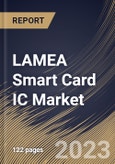A smart card IC may be used to store data or carry out certain functions and inserted into a plastic card. They are utilized in several applications, including access control, identity management, and credit and debit cards. The increased data storage capacity, security, and portability of smart card ICs are some of their main advantages. Due to their difficulty in duplicating and resistance to tampering, smart card ICs offer high security. They are perfect for access control and identity management applications since they can store a lot of data. Smart cards are also transportable and simple to carry in a purse or wallet.
Incorporating the latest technological features in smart cards has further expedited their use. With the help of AI, enterprises can now develop quick, secure apps that adhere to high-security standards. Using smart cards to manage cryptographic keys can make transactions more secure and efficient. Vaults are used to store cryptographic keys. The keys on smart cards can be compared with keys kept in online libraries when they are connected to the Internet through point-of-sale readers. If there is a successful match, users are given authenticated status. This should make it easier for banks as well as other financial ecosystem participants, to secure and validate customers' identities, which would lower the incidence of online theft.
Since issuers are committing to the technology, the proportion of contactless-enabled cards is rising quickly as banking institutions now issue most cards in the region with contactless certifications. As a result of changes in customer behavior brought on by COVID, Latin America is rapidly approaching a turning point in the adoption of contactless technology. Customers and companies have adopted contactless payments throughout Latin America due to their quickness and ease. The popularity of contactless cards is partly due to their convenience and the fact that they are safe and offer robust fraud prevention. In addition, contactless cards have some of the lowest fraud rates of any payment, propelling their use in the region. Therefore, the regional smart card IC market will grow significantly in the coming years.
The Brazil market dominated the LAMEA Smart Card IC Market by Country in 2022, and would continue to be a dominant market till 2029; thereby, achieving a market value of $78.8 million by 2029. The Argentina market is exhibiting a CAGR of 8.7% during (2023-2029). Additionally, The UAE market would showcase a CAGR of 7.9% during (2023-2029).
Based on Type, the market is segmented into Microprocessor and Memory. Based on Interface, the market is segmented into Contactless, Contact and Dual. Based on Application, the market is segmented into USIMs/eSIMs, ID cards, Financial Cards, and IoT Devices. Based on Industry, the market is segmented into Telecommunications, BFSI, Government & Healthcare, Transportation, Education, Retail and Others. Based on countries, the market is segmented into Brazil, Argentina, UAE, Saudi Arabia, South Africa, Nigeria, and Rest of LAMEA.
The market research report covers the analysis of key stake holders of the market. Key companies profiled in the report include Toshiba Corporation, ON Semiconductor Corporation, Microchip Technology Incorporated, STMicroelectronics N.V., Texas Instruments, Inc., Sony Corporation, Analog Devices, Inc., Infineon Technologies AG, Samsung Electronics Co., Ltd. (Samsung Group) and NXP Semiconductors N.V.
Scope of the Study
By Type
- Microprocessor
- Memory
By Interface
- Contactless
- Contact
- Dual
By Application
- USIMs/eSIMs
- ID cards
- Financial Cards
- IoT Devices
By Industry
- Telecommunications
- BFSI
- Government & Healthcare
- Transportation
- Education
- Retail
- Others
By Country
- Brazil
- Argentina
- UAE
- Saudi Arabia
- South Africa
- Nigeria
- Rest of LAMEA
Key Market Players
List of Companies Profiled in the Report:
- Toshiba Corporation
- ON Semiconductor Corporation
- Microchip Technology Incorporated
- STMicroelectronics N.V.
- Texas Instruments, Inc.
- Sony Corporation
- Analog Devices, Inc.
- Infineon Technologies AG
- Samsung Electronics Co., Ltd. (Samsung Group)
- NXP Semiconductors N.V.
Unique Offerings
- Exhaustive coverage
- The highest number of Market tables and figures
- Subscription-based model available
- Guaranteed best price
- Assured post sales research support with 10% customization free
Table of Contents
Companies Mentioned
- Toshiba Corporation
- ON Semiconductor Corporation
- Microchip Technology Incorporated
- STMicroelectronics N.V.
- Texas Instruments, Inc.
- Sony Corporation
- Analog Devices, Inc.
- Infineon Technologies AG
- Samsung Electronics Co., Ltd. (Samsung Group)
- NXP Semiconductors N.V.








